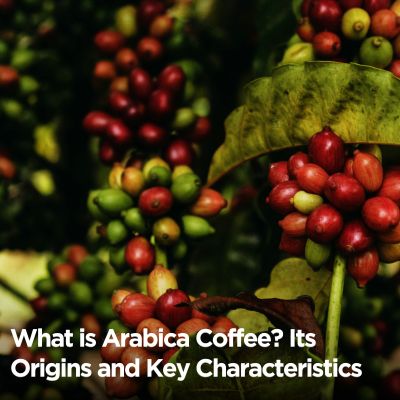Arabica coffee accounts for about 70% of the coffee produced worldwide, making it the most commonly consumed variety. It is celebrated for its smooth, well-rounded flavor and aromatic complexity, distinguishing it from other coffee beans like Robusta.
While Robusta tends to have a stronger, more bitter taste, Arabica offers a more delicate, nuanced cup. It often has fruity, floral, and sometimes nutty notes balanced by a bright acidity.
However, Arabica’s popularity is not just due to its flavor. The beans require specific growing conditions, thriving at higher altitudes in certain climates. This careful cultivation process results in the beans’ premium quality and higher cost.
In this blog, we’ll learn about Arabica coffee’s origins, defining flavor characteristics, the conditions under which it thrives, and its significance in today’s global coffee market.
What is Arabica Coffee?

Arabica coffee, scientifically known as Coffea arabica, is one of the most popular and widely consumed coffee species worldwide. It is renowned for its smooth, mild flavor, making it a favorite among coffee enthusiasts.
Compared to other types of coffee, such as Robusta, Arabica is more delicate and requires specific growing conditions.
It thrives at higher elevations, typically between 2,000 and 6,000 feet above sea level, where cooler temperatures and more consistent rainfall provide the ideal environment for its growth.
Arabica coffee is known not only for its taste but also for its botanical makeup. With 44 chromosomes, it is more genetically complex than Robusta, which only has 22.
This genetic complexity results in a diverse flavor profile, ranging from fruity to floral, and helps explain why Arabica beans are often perceived as superior in quality.
In terms of cultivation, Arabica coffee plants are more vulnerable to diseases and pests than their Robusta counterparts, making them more challenging to grow. However, their unique flavor profile and higher quality have made Arabica coffee the go-to choice for coffee lovers worldwide.
An overview of Arabica coffee would reveal its widespread importance in the coffee industry, and understanding the basics of Arabica coffee helps clarify why it’s so highly valued.
Origins and History of Arabica Coffee
The origin of Arabica coffee can be traced back to the highlands of Ethiopia, where it first grew in the wild more than 1,000 years ago. Its history is intertwined with the culture and commerce of several regions, from its discovery in Ethiopia to its spread across the globe.
In this section, we’ll explore how Arabica coffee began, its journey from Ethiopia, and how it became the coffee we know and love today.
Discovery in Ethiopia
Arabica coffee’s roots can be traced back to the highlands of Ethiopia, where it is believed to have been discovered more than 1,000 years ago. According to legend, a goat herder named Kaldi noticed that his goats became energetic after eating the red berries from a certain plant.
Curious about this effect, Kaldi tried the berries himself and soon found his own energy levels soaring. This led to the discovery of coffee and the beginnings of its use in the region.
While the precise origin of coffee brewing methods is uncertain, it’s widely accepted that the earliest use of coffee was in Ethiopia before it spread beyond Africa. Over time, coffee made its way from Ethiopia to the Arabian Peninsula, marking the beginning of its global expansion.
Spread Through the Arabian Peninsula
Arabica coffee began its journey beyond Ethiopia when it was cultivated in Yemen, where the climate and high altitudes were well-suited for growing the beans. The name “Arabica” is derived from the Arabian Peninsula, where it became deeply embedded in the culture.
The city of Mocha, located on Yemen’s Red Sea coast, became an important trading port for coffee. From here, coffee made its way across the Arabian world and eventually to Europe and beyond, helping to globalize the drink.
Arab merchants were essential in this process, introducing coffee to Egypt, Turkey, and Persia. Their coffee trade helped lay the foundation for today’s global coffee culture.
Global Expansion and Cultivation
As coffee’s popularity grew, colonial powers significantly spread Arabica cultivation throughout Asia, the Americas, and other regions.
The Dutch were among the first to successfully transport Arabica plants to Java (Indonesia) in the 1600s, while the French took them to the Caribbean and South America.
By the 19th century, the cultivation of Arabica had expanded to countries such as Brazil and Colombia, which remain some of the leading producers of Arabica coffee today.
Despite its origins in Ethiopia, Arabica coffee history has seen this variety spread across the globe. Today, countries like Brazil, Colombia, and Ethiopia remain major players in the global coffee market.
Characteristics of Arabica Coffee

Arabica coffee is admired worldwide for its superior flavor, distinct bean structure, and the conditions needed to cultivate it. In this section, we’ll get into its taste profile, appearance, and the specific growing conditions contributing to its high-quality reputation.
1. Taste Profile
Arabica coffee is known for its smooth, sweet taste, often featuring fruity, sugary notes and a high level of acidity. The flavor can vary by region, with beans from different areas offering diverse profiles, such as floral, nutty, or berry-like flavors.
The roast level also affects the flavor — light roasts highlight the bean’s natural acidity and fruity qualities, while darker roasts bring out deeper notes like chocolate and caramel.
Compared to Robusta, which has a harsher, more bitter taste, Arabica is much milder and smoother. It is a go-to choice for drip coffee lovers who appreciate a balanced cup.
2. Bean Structure and Appearance
Arabica beans are oval-shaped, with a curved crease running down one side. They are lighter in color than Robusta beans, giving them a more refined and delicate appearance.
Arabica beans contain around 1.5% caffeine, half the amount in Robusta beans. This lower caffeine content helps give Arabica a smoother taste and allows more delicate flavors.
3. Growing Conditions
Arabica coffee thrives in high-altitude regions, usually between 600 and 2,000 meters above sea level. These cooler climates and shade-grown conditions provide a suitable environment for Arabica plants to grow well.
However, Arabica is more vulnerable to diseases like coffee leaf rust and is generally harder to cultivate than Robusta.
Its susceptibility to pests and diseases requires careful management by farmers, making its cultivation more challenging but ultimately rewarding due to the quality of the beans produced.
Despite these difficulties, Arabica’s delicate flavor profile and smooth finish make it a popular choice among coffee producers and consumers.
Why Arabica is So Popular
Arabica coffee is highly regarded for its smooth, refined flavor, making it a top choice for coffee enthusiasts worldwide. Its premium reputation is backed by its superior taste and the care required for its cultivation.
Arabica’s popularity also extends to its economic and environmental impact, influencing global markets and local farming communities.
1. Premium Market Perception
Arabica is widely marketed as a higher-end coffee, often featured in specialty cafés, gourmet blends, and single-origin offerings. Its smoother flavor and hints of fruit, sugar, and acidity appeal to those seeking a more refined cup.
Because it’s more challenging to grow and yields less per plant than Robusta, Arabica commands a higher price in the market.
Arabica beans are often showcased at events like coffee trade shows, where roasters, buyers, and enthusiasts sample them for their quality and unique flavor notes. This exposure helps reinforce its premium image across the industry.
2. Environmental and Economic Impact
Arabica is crucial to farmers’ livelihoods across Latin America, Africa, and Asia. Its cultivation supports millions of small-scale growers in developing regions, making it vital to local economies.
However, Arabica is highly sensitive to changes in temperature, rainfall, and pests. As climate change intensifies, growing regions are being pushed to higher altitudes, and farmers face new challenges to maintain quality and yield.
Its delicate nature means sustaining Arabica production requires more resources and care, putting pressure on growers and supply chains.
Arabica Coffee Varieties and Regions
Arabica coffee isn’t just one type of bean. It includes various varietals grown across different regions, each offering flavor profiles and farming challenges. These differences impact everything from how the beans taste in the cup to how resilient they are in the field.
1. Popular Arabica Varietals
Some of the most well-known Arabica varietals include Bourbon, Typica, SL28, SL34, Caturra, and Gesha. Each varietal has genetic traits that influence flavor, yield, and resistance to disease.
For example, SL28 is praised for its vibrant acidity and drought resistance, while Gesha is prized for its floral aroma and complexity, often compared to tea.
These differences can greatly affect the coffee’s performance in brewing methods like pour-over and French press coffee, where clarity and subtle flavor are more easily noticed.
2. Notable Arabica-Producing Countries
Brazil leads the world in Arabica production and is known for beans with chocolatey, nutty flavors and low acidity. Colombia is famous for producing smooth, balanced coffee with hints of caramel and nuts.
Ethiopia, considered the birthplace of Arabica, grows beans that are often floral, fruity, and incredibly aromatic.
Terroir, the combination of climate, soil, and altitude, greatly influences each country’s flavor profile. From Guatemala’s high-altitude farms to Rwanda’s volcanic soils, Arabica coffee reflects the land where it’s grown.
How Does Arabica Coffee Grow?

Arabica coffee thrives on small evergreen shrubs that flourish in high-elevation, tropical climates. Typically found between 600 and 2,000 meters above sea level, these plants need cooler temperatures, shade, and well-drained, nutrient-rich soil to grow well.
The growth cycle of an Arabica coffee plant is a delicate process:
- Germination from Seed: Coffee begins as a seed typically planted in rich soil, where it starts to sprout and develop roots.
- Sapling Stage (6-12 Months): Over the first year, sapling grows into a small plant. It requires careful attention, vulnerable to pests and environmental stress.
- Flowering: After the rainy season, Arabica plants bloom with white blossoms. These flowers are crucial for the development of coffee cherries.
- Fruit Development: Over 6 to 9 months, the blossoms turn into coffee cherries, which slowly ripen to their characteristic red or yellow color.
Arabica plants are more delicate than Robusta, requiring precise care and more growing time. They are particularly vulnerable to pests and diseases, making cultivating them more challenging.
This care-intensive process and slower maturation add to Arabica beans’ overall cost and quality.
How to Brew and Enjoy Arabica Coffee
To fully appreciate the rich flavors of Arabica coffee, it’s important to choose the right brewing method and focus on factors like grind size, water temperature, and freshness. The delicate profile of Arabica shines best when brewed with care.
Brewing Methods
- Pour-Over: This method allows for precise control over water flow, bringing out Arabica’s bright acidity and floral notes. Using a medium to fine grind, pour-over brewing creates a clean, flavorful cup.
- Chemex: Similar to pour-over, but with thicker filters, the Chemex removes more oils, creating a crisp, smooth cup that highlights Arabica’s natural sweetness.
- Espresso: Arabica’s complex flavors are perfect for espresso. The concentrated, intense extraction brings out its fruity and chocolaty tones. A fine grind and consistent tamping are essential for the best espresso shot.
- French Press: If you prefer a fuller-bodied brew, French press coffee retains oils from the beans, giving Arabica a rich, smooth taste with its natural sweetness and balanced acidity.
Key Brewing Tips
- Grind Size: Choose a grind size suited to your brewing method. A coarser grind works well for French press, while medium grinds are best for pour-over and Chemex.
- Water Temperature: Use water between 195°F and 205°F (90°C–96°C) for the best extraction. Too hot or cold can lead to over or under-extraction, affecting flavor.
- Freshness: Always use freshly ground Arabica beans. Coffee tastes best when brewed within two weeks of roasting.
Roast Recommendations
To enjoy the full flavor profile of Arabica coffee, opt for light to medium roasts. These preserve the bean’s natural complexity, highlighting its fruity, floral, and sweet notes without overwhelming bitterness.
Lighter roasts bring out the subtlety of Arabica’s flavor, allowing the full range of taste to shine through.
Conclusion
Arabica coffee stands out for its rich history, refined flavor, and global impact. From its origins in Ethiopia to its widespread worldwide cultivation, Arabica beans have earned a reputation for their smooth, sweet taste and complex profile.
Its popularity in specialty coffee markets is a testament to its high quality and versatility. For coffee lovers eager to explore Arabica’s full potential, visiting local roasters or attending coffee trade shows can offer a deeper understanding of the diverse varieties and brewing methods.
Whether you’re a casual drinker or a dedicated connoisseur, Arabica coffee provides an endless journey of flavors to discover.













